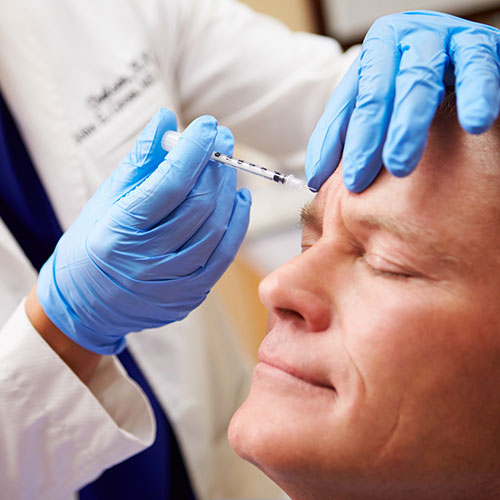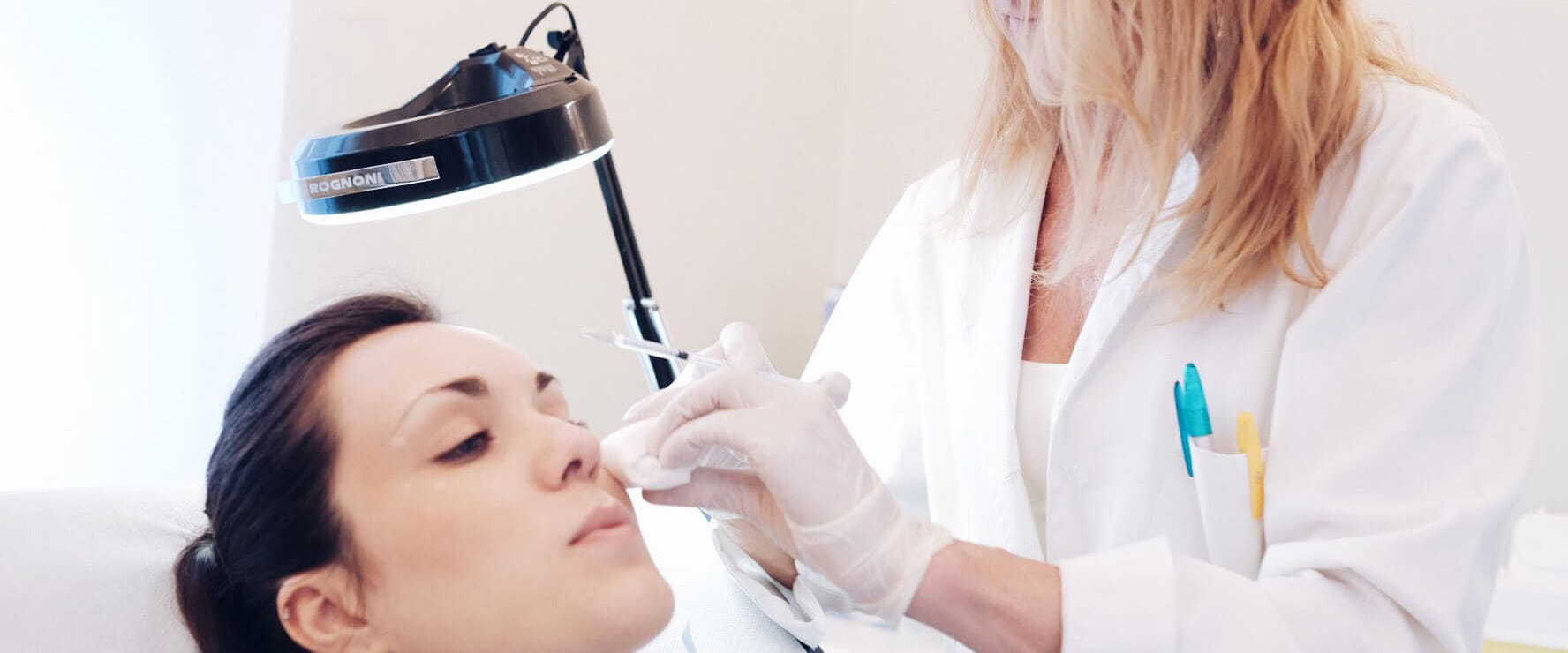Say Goodbye to Wrinkles with Botox
Frowning the forehead and eyebrows, wrinkling the nose, squinting when smiling, these are all constant stresses on the facial mimetic muscles.
We all primarily express our emotions through facial expressions, but as we age, this leads to the typical expression lines, which are aesthetically unpleasant. The most common are those in the center of the forehead and the classic "crow’s feet" around the eyes.
Aesthetic medicine has explored various solutions to address the issue of unwanted wrinkles. Among the most widespread and safest are those that use botulinum toxin. According to data collected by AITEB (Italian Association of Botulinum Aesthetic Therapy), approximately 300,000 botulinum injections were performed in 2015, a 12.5% increase compared to the previous year.
This technique, now widely tested and refined, allows excellent results to be achieved in a short time, using non-invasive methods at costs accessible to everyone.

Botox: What It Is
Botox is the brand name of a drug based on type A botulinum toxin. Botulinum is known as a bacterium that can contaminate food, causing botulism.
Medical science discovered that when injected in small doses and at appropriate dilutions into certain muscle tissues, it acts as a muscle relaxant by blocking the chemical signals from nerve endings that trigger muscle contractions. Botulinum toxin was first used in humans in the 1970s to treat blepharospasm, nervous tics and chronic torticollis.
Aesthetic medicine has leveraged this clinical experience to use botulinum in treating facial imperfections. The final effect of this procedure is targeted neuromodulation that leads to the smoothing of expression lines. The areas treated are mainly between the eyebrows, the forehead and around the eyes. In particular, it can produce a lifting effect on the eyebrow, restoring a relaxed and youthful appearance.
Botulinum toxin is harmless when used in infinitesimal and localized quantities, always under the supervision of experienced professionals. Besides aesthetic purposes, it is also used to treat other conditions related to muscle spasms, such as neck muscle stiffness (cervical dystonia), migraines and excessive sweating of the underarms and hands.
Over the years, the technique involving botulinum toxin has been increasingly refined to avoid the “mummy effect” caused by excessive muscle stiffness. Improvements have been made to the product’s dilution, previously excessive doses and the study of skin areas.
It should be noted that botulinum is only effective on mimetic muscle wrinkles and is not suitable for correcting damage caused by skin aging or excessive sun exposure. In such cases, it may be advisable to combine it with other treatments, such as fillers (hyaluronic acid), biorevitalization, PRP, etc.
How It Works
The session is performed in a clinic setting, without hospitalization or anesthesia and typically lasts 15–20 minutes, depending on the number of areas to be treated. The treatment is virtually painless, usually limited to a slight discomfort that is fully tolerable and very brief.
The toxin is injected using a syringe with an extremely fine needle, in moderate doses, into the mimetic muscles, those that, through repeated contractions, create the expression lines to be eliminated. The number of injections depends on the anatomical evaluation of the area by the specialist, who should first observe how the patient frowns and mark the injection points.
It is essential that the procedure be preceded by a thorough clinical examination by an experienced physician who will evaluate the type and thickness of the skin, the depth and characteristics of the wrinkles and any contraindications related to the patient’s health. It may be necessary to discontinue certain medications, especially anticoagulants.
The results of Botox treatment are noticeable after about a week and reach maximum visibility after about a month. However, the benefits are not permanent and gradually fade after 4–6 months, which is why it is recommended to repeat the treatment twice a year.
Normal daily activities can be resumed almost immediately. Makeup can be reapplied just ten minutes after the injections and sun exposure is allowed after about 10 days. Care should be taken not to massage or rub the treated areas.
Side Effects and Contraindications
The safety of botulinum toxin therapy is ensured by years of research, practically excluding serious complications and having no real age limits, from age 20 onwards.
Facial skin may appear slightly red immediately after the injections, an effect that lasts only a few minutes. Occasional small bruises or slight burning sensations may also occur, resolving within a few days. Allergic reactions are very rare, as is ptosis (drooping of the upper eyelid), which is reversible within 3–4 weeks.
In the hours following treatment, it is advisable to avoid saunas, steam baths and tanning lamps.
The only contraindications are for pregnant individuals or those with specific allergies or neuromuscular disorders.
At Your Service
In the case of Botox treatment, even more so than with other aesthetic medicine techniques, the supervision of experienced and professional personnel is essential to avoid improper use of botulinum toxin.
My team can provide you with all the information about the Botox procedure and help you identify your needs and the optimal results to achieve. Analyzing the problem, carefully choosing the doses and selecting the facial areas to treat are essential elements for a successful treatment.
1
2
What is Botox?
It’s a drug, but it also exists in nature and is produced by a bacterium, Clostridium Botulinum.
How toxic is it?
Botox is injected at an extreme dilution, making it virtually impossible to cause harm to the patient.
4
What are its applications?
For over 20 years in ophthalmology for blepharospasm, in neurology for spastic torticollis and for hyperhidrosis (excessive sweating). For aesthetic purposes, it is currently injected to treat expression lines: glabellar wrinkles, “crow’s feet,” and forehead wrinkles.
7
What effect does it have?
Nerves produce and carry a chemical substance that enables muscle contraction. Botulinum injected into the muscle temporarily blocks signal transmission between nerve and muscle cells. The muscle becomes paralyzed, not immediately, but within 3–5 days.
9
10
Are there allergies?
No, only rare cases of hypersensitivity to albumin, used as an excipient.
Are there any side effects?
There may be mild burning at the injection site or slight redness, which resolve within a few hours.
3
What are the contraindications?
Myasthenia gravis (a generalized alteration in muscle activity). Lambert–Eaton syndrome (a disorder of muscle activity occurring with autoimmune diseases). Treatment with aminoglycoside antibiotics. Pregnancy and breastfeeding.
5
6
How long does the effect last?
About 5–6 months, sometimes more.
What precautions should be taken before treatment?
It is advised to stop taking certain medications such as anticoagulants and vitamins C and E 5 days before, to reduce the risk of minor bruising.
8
What should be avoided after treatment?
Avoid massaging the treated area for at least 6 hours, intense physical activity especially with the head down and sun or tanning lamp exposure in the following days.
11
12
Does the effect decrease if the injection is repeated multiple times?
No, there is no tolerance: once the efficacy period ends, the muscle returns to its normal state.
Is it degradable by the human body?
Yes, 100%.
Treatment Videos:
Smooth out the lines, not your personality


